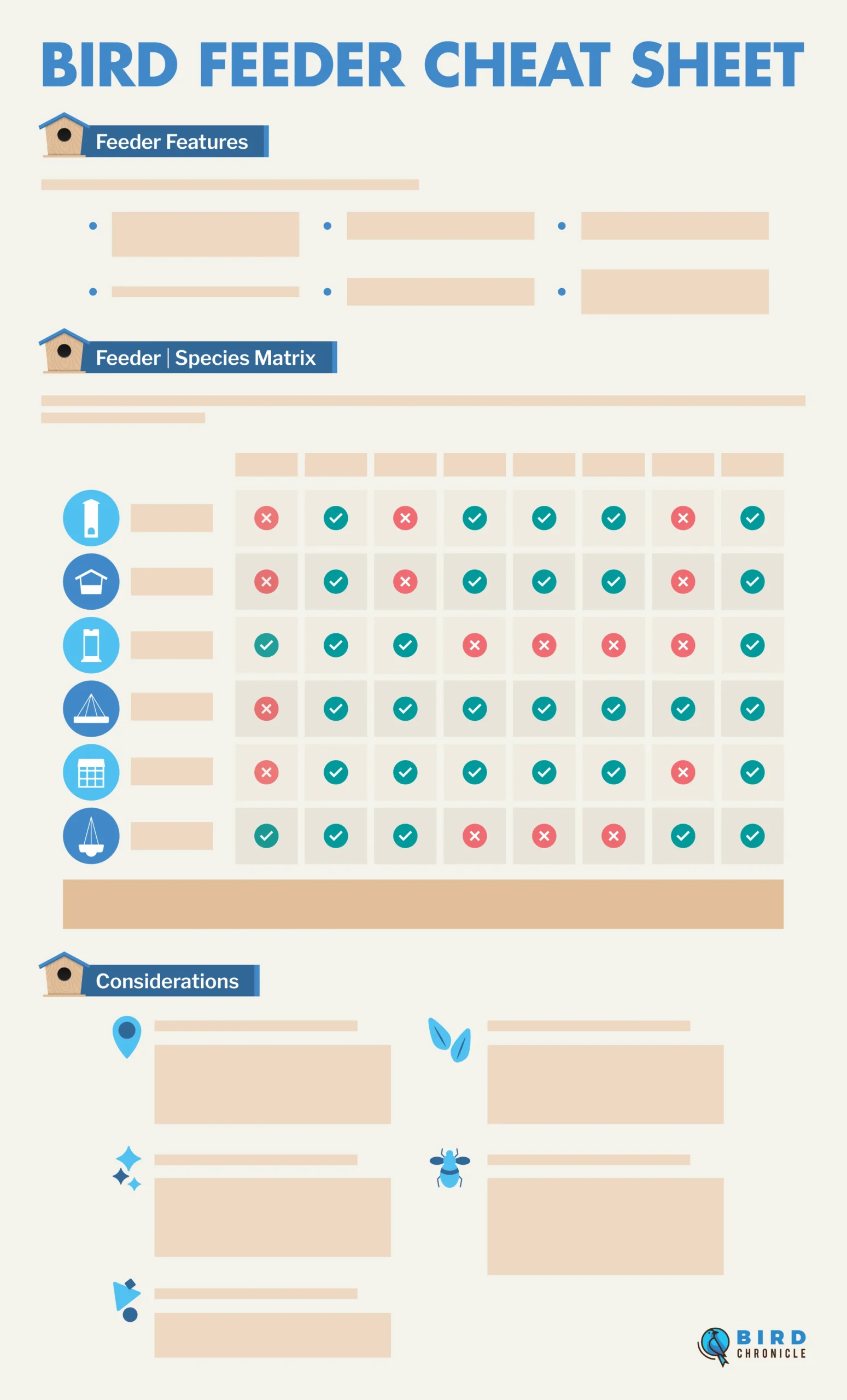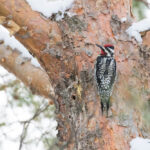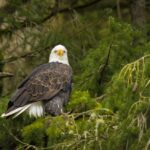Bald eagles (Haliaeetus leucocephalus) are a symbol of the United States of America and one of the most prolific types of eagles in the nation. They are established throughout all 48 lower states as well as other parts of North America, including Canada and Alaska.
These gorgeous birds of prey prefer wetter habitats. They are normally found within two to three miles of coasts, bays, rivers, lakes, and other bodies of water.
While bald eagles are illegal to hunt, sell, or possess, they have become a nuisance in some areas.
Whether you want to find the chances of spotting a bald eagle on your trip or wonder whether it could prey on your poultry, here are the latest stats and trends of the bald eagle population by state.
Key Facts
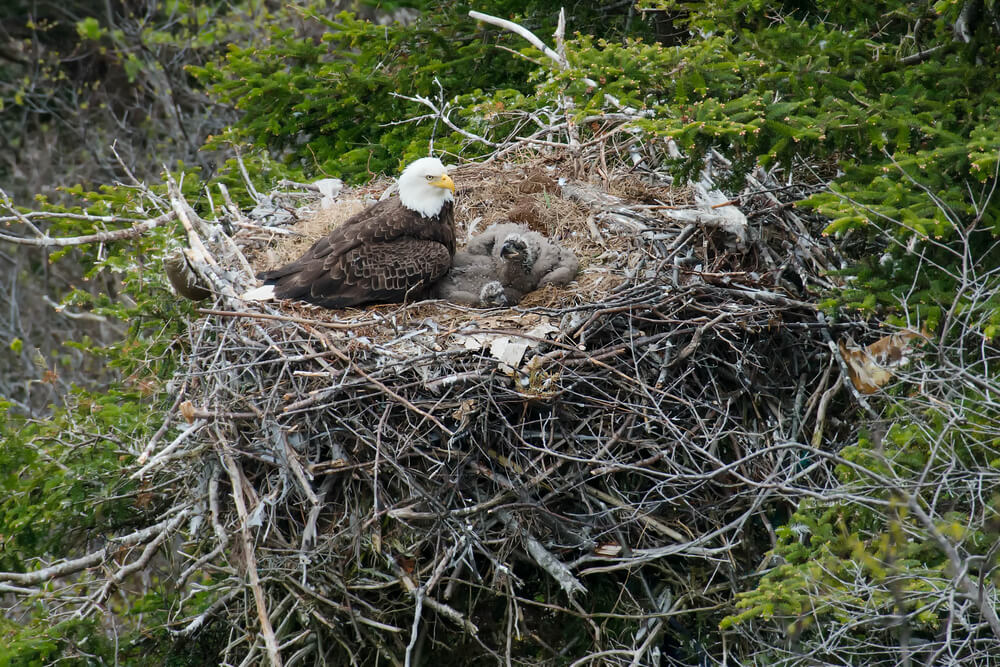
- There are around 316,700 individual bald eagles throughout the United States, excluding the jurisdictions that provide no census or population density data.
- Bald eagles are present in all 48 continental states and in Alaska. The only state with no bald eagle population is Hawaii.
- Alaska is the state with the most bald eagles in the USA, counting around 30,000 breeding pairs and a total population between 100,000 and 150,000.
- Most states monitor the number of bald eagle breeding pairs, but not a total population census that includes chicks and juveniles.
- Bald eagles have been the national emblem for over two centuries. They are illegal to hunt, possess, or sell in all states.
The table below shows the estimated numbers of bald eagles in each state:
| Jurisdiction | Bald Eagle Population* | Estimated Number of Breeding Pairs** |
|---|---|---|
| Alabama | N/A | 100 – 200 |
| Alaska | 100,000 – 150,000 | 30,000 |
| Arizona | 143 – 200 | 65 |
| Arkansas | 1,700 | 80 |
| California | 1,000 | 400 |
| Colorado | N/A | 200 |
| Connecticut | 100 – 150 | 75 |
| Delaware | 200 | 77 |
| Florida | N/A | 1,500 |
| Georgia | 510 | 141 |
| Hawaii | 0 | 0 |
| Idaho | 832 | 234 |
| Illinois | 3,100 | 40 |
| Indiana | 1,000 | 350 |
| Iowa | 6,000 | 400 |
| Kansas | 3,000 | 137 |
| Kentucky | N/A | 187 |
| Louisiana | N/A | 356 |
| Maine | N/A | 800 |
| Maryland | N/A | 1,400 |
| Massachusetts | N/A | 76 |
| Michigan | N/A | 900 |
| Minnesota | N/A | 9,800 |
| Mississippi | 50 | 46 |
| Missouri | 2,000 | 587 |
| Montana | N/A | 800 |
| Nebraska | 990 | 200 |
| Nevada | 137 | 0 |
| New Hampshire | 816 | 81 |
| New Jersey | 835 | 250 |
| New Mexico | 67 | 2 |
| New York | 1,000 | 173 |
| North Carolina | N/A | 192 |
| North Dakota | N/A | 300 |
| Ohio | 553 | 110 |
| Oklahoma | 500 | 249 |
| Oregon | N/A | 570 |
| Pennsylvania | N/A | 300 |
| Rhode Island | N/A | 5 |
| South Carolina | N/A | 220 |
| South Dakota | N/A | 300 |
| Tennessee | 500 | 175 |
| Texas | 524 | 160 |
| Utah | 3,000 - 4,000 | 11 |
| Vermont | 88 | 38 |
| Virginia | 1,500 - 2,000 | 340 |
| Washington | N/A | 9,000 |
| West Virginia | 56 | 130 |
| Wisconsin | N/A | 1,695 |
| Wyoming | 576 | N/A |
*Population size estimates were sourced from/provided by Wildlife Department reports, scientific papers, news outlets, studies, and other official sources cited throughout the article. Data is correct as of July 2023 and intended to use as a reference only. All figures are subject to change and can be updated by the relevant authorities at any given time.
**Breeding pair numbers are based on reports received by government departments from nest monitoring authorities. They are not an indicator of population density in a region and are intended to use as a reference only.
Bald Eagle Population Trends by State
Alabama
- Estimated population size: N/A
- Breeding pairs: 100 to 200
Alabama is one of the states that doesn’t provide an official census for their bald eagle population. However, the state does count its breeding pairs.
According to the Alabama Department of Conservation and Natural Resources, the state counts around 100 to 200 breeding pairs. Considering that most bald eagles in Alabama are permanent residents, we can assume the permanent population to be at least twice as large.
However, if we were to count the number of juvenile eagles, the size of the bald eagle population in Alabama likely exceeds 500.
Alaska
- Estimated population size: 100,000 to 150,000
- Breeding pairs: 30,000
Unlike Alabama, Alaska knows exactly how many bald eagles it has. Like all northern states, Alaska has a migratory population of bald eagles with an estimated 30,000 breeding pairs.
According to the Wildlife Department, the number of bald eagles in Alaska, including eaglets and non-breeding adults, is around 100,000 to 150,000.
Arizona
- Estimated population size: 143 to 200
- Breeding pairs: 65
Arizona is one of the states with the fewest bald eagles. The Grand Canyon State counts around 65 breeding pairs and a total population size of around 200.
This could seem like a very low number, but the truth is that the bald eagle population in Arizona is on the rise.
Most bald eagles in the state are found along the Salt and Verde rivers, although isolated sightings were reported near Woods Canyon Lake.
Arkansas
- Estimated population size: 1,700
- Breeding pairs: 80
While the breeding population of bald eagles in Arkansas is of only 80 pairs, the state has an estimated total population of 1,700 birds.
Most of these birds are migratory rather than permanent residents, reaching the state in October and staying until March, when they return to their breeding place.
Resident bald eagles in Arkansas can be spotted year-round along the Arkansas River, as well as other rivers and lakes across the state.
California
- Estimated population size: 1,000
- Breeding pairs: 400
Similar to Arkansas, California is mostly a wintering state. The best time to spot bald eagles in California is from December to March, when the estimated population of adult eagles reaches around 1,000 individuals.
However, this doesn’t mean there are no permanent residents. Out of all the bald eagles counted during winter, about 800 remain in California year-round—400 breeding pairs.
Hence, the actual population could be a lot higher than 1,000, considering all eaglets and non-breeding adults.
Colorado
- Estimated population size: N/A
- Breeding pairs: 200
Colorado joins Alabama as a state that offers no official census for its bald eagle population. The only official data regards the number of permanent breeding pairs, which currently is around 200.
Simple math tells us that at least 400 adult eagles live in Colorado year-round. Eaglets and non-breeding adults can easily double the estimates, and the winter population could be much higher when considering the migratory eagles.
Despite a lack of exact numbers, the population of bald eagles in Colorado thrives thanks to the non-hunting policy and the reduction in the use of pesticides.
Connecticut
- Estimated population size: 100 to 150
- Breeding pairs: 75
Despite being a northern state, Connecticut is one of the states with the smallest population of bald eagles. The Constitution State counts around 150 individuals and about 75 breeding pairs.
It is uncertain whether these eagles migrate south during winter or are permanent residents. However, according to official data, the birds are no longer considered endangered.
Delaware
- Estimated population size: 200
- Breeding pairs: 77
The population of bald eagles in Delaware isn’t much larger than the population in Connecticut. In fact, the state has an estimated 200 individuals and 77 breeding pairs.
These numbers refer to the resident population. Each winter, migratory bald eagles arrive in Upper Delaware from Canada and Alaska and spend the cold season before returning to their nesting spots in spring.
Florida
- Estimated population size: N/A
- Breeding pairs: 1,500
Florida is one of the hottest states in North America, but surprisingly, it has one of the largest populations of bald eagles in a southern state.
Like many jurisdictions, the Florida Wildlife Department doesn’t provide official census numbers. However, wildlife experts counted the number of used nests, and concluded that there are around 1,500 breeding pairs.
This brings the number of permanent residents to at least 3,000, without counting the eaglets and non-breeding adults. In winter, these numbers are likely to go up, as the migratory eagles add up to the permanent residents.
Georgia
- Estimated population size: 510
- Breeding pairs: 141
Georgia, like most of the United States, is one of the states where the bald eagle population was threatened with extinction.
Conservation measures paid off, though, and today, the estimated population of bald eagles in Georgia is around 510. About 282 of these eagles are breeding adults, resulting in around 141 breeding pairs.
Hawaii
- Estimated population size: 0
- Breeding pairs: 0
From all federal states, Hawaii is the only one that doesn’t have—and has never had—bald eagles. The tropical territory is too hot for these birds of prey to thrive in.
Idaho
- Estimated population size: 832
- Breeding pairs: 234
From no bald eagles in Hawaii to around 234 breeding pairs in Idaho, we can safely say that this species thrives in 49 out of the 50 federal states.
But even if the Gem State has only 832 permanent residents, the population of bald eagles in Idaho more than doubles in winter.
Most bald eagles arrive in the state between January and February, even though the first migratory pairs arrive much earlier, in October. Most of them gather around Lake Coeur d’Alene and Lake Pend Oreille, as well as the banks of Salmon, Snake, and Boise rivers.
While most eaglets born in Idaho turn into permanent residents, some young eagles turn migratory and choose to winter in California, before returning to Idaho for breeding in the warm season.
Illinois
- Estimated population size: 3,100
- Breeding pairs: 40
The Prairie State is a bit of a paradox. The estimated population of bald eagles in Illinois is around 3,100, but experts estimate that only about 80 adults breed in the state.
This happens because most bald eagles in Illinois are transitory birds migrating from Alaska. The first individuals land around the state’s rivers and lakes in December and roost until March, when they turn back north.
This pattern makes January and February the best months for bald eagle watching in Illinois.
Indiana
- Estimated population size: 1,000
- Breeding pairs: 350
Similar to many other states, the population of bald eagles in Indiana has risen in numbers in recent years. Currently, there are around 1,000 bald eagles in the state year-round, and about 700 of these are breeding adults.
However, Indiana is one of the few states where the situation might be less than optimal. While the use of DDT has been banned since the 1970s, apparently lead poisoning threatens not only the bald eagles but also other marine and land species in the state.
It is not yet sure what is the source of lead poisoning, although most experts claim it could come from bullet fragments and shotgun pellets left on the ground after hunting.
Iowa
- Estimated population size: 6,000
- Breeding pairs: 400
Iowa brags with one of the largest populations of bald eagles in America after Alaska. In fact, the estimated population counts around 6,000 individuals.
The situation is similar to other states that see an increase in numbers in winter and a decrease in the breeding season.
However, that doesn’t mean that the state has few breeding pairs. On the contrary. Iowa boasts 400 used nests, meaning that at least 800 adults are permanent residents.
Kansas
- Estimated population size: 3,000
- Breeding pairs: 137
The situation in Kansas is similar to Iowa, although on a smaller scale. The number of bald eagles in the Sunflower state is 3,000, including migratory adults and juveniles spotted in wintertime. However, there are only 137 breeding populations, so around 274 resident adults.
Spotting typically occurs from early November through to mid or late March, mostly around the banks of the Kaw River.
Bald eagles in Kansas can also be spotted in other wetlands where water remains unfrozen throughout the winter.
Kentucky
- Estimated population size: N/A
- Breeding pairs: 187
With no census of bald eagle population, Kentucky is one of the states that claims the numbers are on a continuous rise.
Currently, there are around 187 used nests in the state, which doubles the adult population. Together with juvenile and non-breeding adults, we can estimate a permanent population of over 500 individuals.
Louisiana
- Estimated population size: N/A
- Breeding pairs: 356
Louisiana’s population of bald eagles isn’t officially counted, either. However, state officials claim that there are around 356 breeding pairs.
With around 700 individuals as permanent residents and hundreds of others arriving in the state for winter, bald eagles are easy to spot all across the Child of Mississippi.
Maine
- Estimated population size: N/A
- Breeding pairs: 800
Similar to Louisiana and Kentucky, Maine provides no official numbers regarding the resident population of bald eagles. However, we know that there are 800 breeding pairs, meaning at least twice as many adults permanently residing in the state.
The reason for such a thriving population is the effort of biologists and the Wildlife Department who strived to preserve the species.
While no longer in use, Maine was one of the few states to run feeding stations for bald eagles and other endangered bird of prey species.
Their efforts boosted the survival rate by around 73 percent in periods in which this iconic species was threatened with extinction in most of the United States.
Maryland
- Estimated population size: N/A
- Breeding pairs: 1,400
Maryland joins Maine, Louisiana, and Kentucky. The state provides no data on the actual number of bald eagles in Maryland, but there are around 1,400 breeding pairs.
This number is also unofficial, as the state stopped recording breeding pairs back in 2004, when the Wildlife Department counted nearly 400 breeding pairs statewide.
However, considering that most bald eagles in Maryland are found in the Chesapeake Bay area, which is shared with Virginia, the actual number of breeding pairs currently in Maryland is pretty easy to estimate.
That said, there are believed to be over 3,000 breeding pairs of bald eagles in the Bay alone, so the total numbers for Maryland could be higher.
Massachusetts
- Estimated population size: N/A
- Breeding pairs: 76
While Massachusetts doesn’t have a bald eagle census either, this is one of the states with the fewer bald eagles in the United States.
Currently, there are believed to be around 76 breeding pairs of bald eagles in Massachusetts, so the total number of bald eagles—including juveniles and non-breeding adults, might not exceed 500.
Michigan
- Estimated population size: N/A
- Breeding pairs: 900
Michigan is another state that soared back to life, at least as far as the life of bald eagles is concerned. The state currently counts around 900 breeding pairs, which means at least 1,800 resident adults.
Similar to other northern states, Michigan sees an increment in bald eagle numbers in winter, when residents from Alaska migrate for roosting.
Minnesota
- Estimated population size: N/A
- Breeding pairs: 9,800
With the highest population of breeding bald eagles after Alaska, Minnesota earns itself the title of the lower state with the most bald eagles.
It is hard to estimate the actual numbers with no official census, but there are around 9,800 breeding pairs in the state. This easily boosts the total population to at least 20,000 individuals.
Mississippi
- Estimated population size: 50
- Breeding pairs: 46
One of the states with the fewest bald eagles, Mississippi has an estimated population of only 50 individuals. Surprisingly, though, there are 46 breeding pairs in the state, or at least 92 adults during the breeding season.
The paradox is easily explained by the fact that these pairs are likely to winter in neighboring states. Hence, they only come to Mississippi during the warm season.
Missouri
- Estimated population size: 2,000
- Breeding pairs: 587
One of the best places to spot bald eagles in winter, Missouri joins the list of states with a thriving population of these amazing birds.
Currently, there are an estimated 2,000 bald eagles in Missouri, and over a half of these are breeding adults—the number of breeding pairs is 587.
The best spots to see bald eagles in the state, aside from the Eagles Bluff Conservation Area, are the Lake of the Ozarks, the Lock and Dam 24 and 25, and the Mingo National Wildlife Refuge.
Montana
- Estimated population size: N/A
- Breeding pairs: 800
Without providing an official census, Montana is a state with one of the healthiest bald eagle populations in North America.
Around 800 breeding pairs return to the area each breeding season, which lasts from March to August, to lay their eggs and raise the new generation.
All this is possible thanks to the Conservation Corner’s efforts to create an undisturbed habitat.
In fact, bald eagles are likely to abandon their nests if disturbed by humans during the breeding season, which is why the protected area is often off-limits during the peak months.
Nebraska
- Estimated population size: 990
- Breeding pairs: 200
A prime spot for bald eagle breeding, Nebraska sees an increment in the raptor population during the warmer months. It is estimated that there are around 990 individuals in the area and around 200 breeding pairs.
The species was removed from the state’s threatened list in 2008, and Nebraska stopped monitoring the breeding pairs five years later, in 2013. Hence, the actual number of breeding pairs and the population size could be much higher.
Nevada
- Estimated population size: 137
- Breeding pairs: 0
One of the hottest states in the USA, Nevada is not a breeding spot for bald eagles. In fact, apart from Hawaii, this is the only federal state with no breeding pair of bald eagles.
There are seasonal residents, though, typically from November or December to March. According to the latest estimates, there are about 137 eagles that winter in Nevada.
Most of these birds are easy to spot in the Lake Mead area, although they can also be found along rivers and other wetlands.
New Hampshire
- Estimated population size: 816
- Breeding pairs: 81
A lot chillier than Nevada, New Hampshire has plenty of bald eagles for a state its size—816, to be precise. Out of these, around 162 are breeding adults, for a total of 81 breeding pairs. The rest are non-breeding adults and juveniles.
It should be said that these numbers refer to the resident population of bald eagles in New Hampshire. The numbers grow in winter, when bald eagles from Alaska and Canada go south for roosting.
New Jersey
- Estimated population size: 835
- Breeding pairs: 250
Not so far from New Hampshire, New Jersey boasts similar numbers. Currently, the state counts around 250 breeding pairs, and there are 835 bald eagles in New Jersey.
Like most other states, New Jersey is one of those places where conservation efforts paid off. With the band of DDT and other toxic pesticides, the bald eagle population keeps exploding in the state.
Many of these bald eagles reside in the lands that buffer and border the Cohansey River, but younger pairs tend to expand the territory, with four breeding pairs known to reside in Mercer County Park.
New Mexico
- Estimated population size: 67
- Breeding pairs: 2
While New Mexico isn’t an eagle-less state, it doesn’t thrive either. In fact, there are only two breeding pairs of bald eagles in the area.
However, the state does see an increment in numbers during winter. Moreover, it also counts permanent residents.
While there are no official census data for the entire state, some counties and districts provide their own numbers. For instance, there are 67 bald eagles in the Albuquerque district alone.
New York
- Estimated population size: 1,000
- Breeding pairs: 173
Next to New Jersey, New York has a similar—albeit slightly larger—population of bald eagles. There are around 1,000 known individuals in the area, the number including the resident bald eagles of New York City.
However, there are fewer breeding pairs compared to New Jersey—in New York, there are only 173 of them.
Apart from New York City, some of the best places to spot bald eagles in New York include the Verplanck waterfront and George’s Island Park in Montrose.
North Carolina
- Estimated population size: N/A
- Breeding pairs: 192
North Carolina may seem like one of those states where bald eagles go only for wintering. However, the state actually has a resident population of these raptors.
According to the latest data, there are around 192 breeding bald eagles in North Carolina. This translates to just under 400 adults.
Adding the juveniles and the non-breeding population, it is likely to find around 1,000 bald eagles throughout the Old North State.
North Dakota
- Estimated population size: N/A
- Breeding pairs: 300
Crossed by the Missouri River and home to numerous lakes, North Dakota is one of the best spots for bald eagles to breed.
According to the state’s Wildlife Department, there are around 300 active nests. This means twice as many breeding adults, plus eaglets.
Almost all river and lake areas are key nesting spots. However, North Dakota is not one of the best states for spotting bald eagles during the breeding season, considering that you should leave the raptors undisturbed.
Ohio
- Estimated population size: 553
- Breeding pairs: 110
Bald eagles are also found in Ohio, where the resident population counts around 553 individuals. About a half of these are breeding adults, for a total of 110 breeding pairs.
If you want to spot any of these majestic birds—during the non-breeding season—you can head off to the marsh region of the western Lake Erie.
This ideal spot provides a secluded homesite for nesting and ample food within a short distance from the nesting area.
Oklahoma
- Estimated population size: 500
- Breeding pairs: 249
Oklahoma’s population of bald eagles is slightly smaller than Ohio’s, with around 500 individuals. However, there are almost two times as many breeding pairs, which can only mean one thing—younger adults leave their nests and migrate to neighboring states.
That said, the bald eagle is not a rare sight in Oklahoma. From the Chickasaw National Recreation Area to the Arcadia Lake and all other wetlands in the state, spotting bald eagles in Oklahoma is a breeze.
Oregon
- Estimated population size: N/A
- Breeding pairs: 570
The Beaver State doesn’t provide official census data. However, there are around 570 breeding pairs. Simple math tells us that there are at least 1,140 bald eagles in Oregon.
It goes without saying that there are likely many more, including non-breeding adults and juveniles.
The best areas to spot these majestic birds in Oregon include the Oregon Cascades Birding Trail and the Columbia Gorge Discovery Center, just west of The Dalles.
Pennsylvania
- Estimated population size: N/A
- Breeding pairs: 300
Pennsylvania is another of those states that have seen an increment in bald eagle numbers in recent years.
Currently, there are around 600 adult bald eagles in Pennsylvania, which works out to 300 breeding pairs.
The best spot to observe these birds is the aptly named Bald Eagle State Park. However, your chances of seeing an eagle in flight are also high in all the other parks in the region.
Rhode Island
- Estimated population size: N/A
- Breeding pairs: 5
Rhode Island is the smallest state, so it doesn’t come as a surprise that it has one of the smallest populations of bald eagles.
In fact, there are only 5 documented breeding pairs, which works out to 10 adult individuals. There might be some juveniles, too, but an official census is lacking.
South Carolina
- Estimated population size: N/A
- Breeding pairs: 220
Not so distant from North Carolina, South Carolina is home to a slightly larger population of bald eagles. According to the latest data, there are around 220 breeding pairs here.
As it happens in most states, the thriving population is the result of restoration efforts. Monitoring programs include aerial surveys during the breeding seasons and the counting of used nests. Hence, there is no census data.
That said, if you want to see bald eagles in South Carolina, your best bet are the major river drainages of the Lower Coastal Plain.
South Dakota
- Estimated population size: N/A
- Breeding pairs: 300
South Dakota competes with North Dakota in terms of bald eagle numbers. Surprisingly, the two states have the same number of breeding pairs each—300.
Similar to its northern sibling, South Dakota doesn’t provide actual census numbers. However, the national bird can be spotted along the Missouri River and the Lake Andes National Wildlife Refuge Complex.
Tennessee
- Estimated population size: 500
- Breeding pairs: 175
Unlike South and North Dakota, Tennessee provides an estimated bald eagle population size. According to official data, there are around 500 individuals and 175 breeding pairs in the state.
In addition to these eagles, the numbers go up in winter when migrating bald eagles reach the shores of the lakes and rivers in the state.
There are multiple viewing opportunities in Tennessee during winter, especially in the Chickamauga and Watts Bar areas.
Texas
- Estimated population size: 524
- Breeding pairs: 160
The population of bald eagles in Texas is about the same size as that of Tennessee; there are around 524 individuals.
Out of these, over 300 are breeding adults, and the rest are non-breeding adults and juveniles. However, given that nest monitoring often happens before hatching, the numbers could be higher in the warm season.
The numbers go up in the cold season, too, due to the addition of migratory bald eagles who winter in Texas.
Utah
- Estimated population size: 3,000 to 4,000
- Breeding pairs: 11
Similar to Nevada, Utah is one of the warmest states. Bald eagles rarely remain here during the breeding season, usually flying north by mid to late March.
Nevertheless, there is a huge increase in bald eagles in Utah during the cold season. There are so many raptors that roost in this state that official census data counts around 3,000 to 4,000 individuals.
However, only 22 of these are permanent residents, Utah counting 11 breeding pairs of bald eagles.
Vermont
- Estimated population size: 88
- Breeding pairs: 38
Vermont might enjoy cooler weather than Utah, but it isn’t one of the top bald eagle states. In fact, it sits near the bottom of the list, with a permanent population of only 88 individuals.
Out of these, 76 are breeding adults for a total of 38 breeding pairs. What these numbers suggest is that young adults find homes in the nearby states once they leave their native nest.
Virginia
- Estimated population size: 1,500 to 2,000
- Breeding pairs: 340
Virginia’s population of bald eagles is about half that of Utah, but the surprising fact is that it has many more breeding pairs—340, to be exact.
These numbers come after the bald eagle population in the state quadrupled in the last decade.
Considering the environmental efforts, it is likely to see the population grow even further, not only in the number of permanent residents but also in the number of transitory bald eagles that only choose Virginia for wintering.
Washington
- Estimated population size: N/A
- Breeding pairs: 9,000
After Alaska and Minnesota, Washington is the state with the highest number of breeding bald eagles in the United States. There are around 9,000 pairs, which translates to at least 18,000 adults.
It goes without saying that there are also juveniles and non-breeding adults, but the state doesn’t provide official census data. Nevertheless, this is one of the best states for bald eagle birdwatching.
West Virginia
- Estimated population size: 56
- Breeding pairs: 130
Smaller than Virginia, West Virginia impresses with 130 breeding pairs of bald eagles. What it doesn’t impress with is the number of permanent residents, which is only 56.
These numbers suggest that some bald eagles normally residing in surrounding states choose West Virginia as a breeding spot alone.
Wisconsin
- Estimated population size: N/A
- Breeding pairs: 1,695
Wisconsin is another state that doesn’t count its bald eagles, except for the active nests which are around 1,695.
Considering that not all breeding adults remain in the breeding area year-round, the number of permanent residents might slightly drop in winter.
However, the actual number of bald eagles in Wisconsin is likely higher in the cold season, as migratory birds arrive for roosting.
Wyoming
- Estimated population size: 576
- Breeding pairs: Unknown
Wyoming is the only state that knows how many individual bald eagles reside on its territory, but that doesn’t track the number of active nests.
Currently, there are around 576 bald eagle individuals in Wyoming. It is unlikely how many of these are breeding adults, but the population is thriving. Thus, we can only assume that plenty of them reproduce.
Bald Eagle Identification
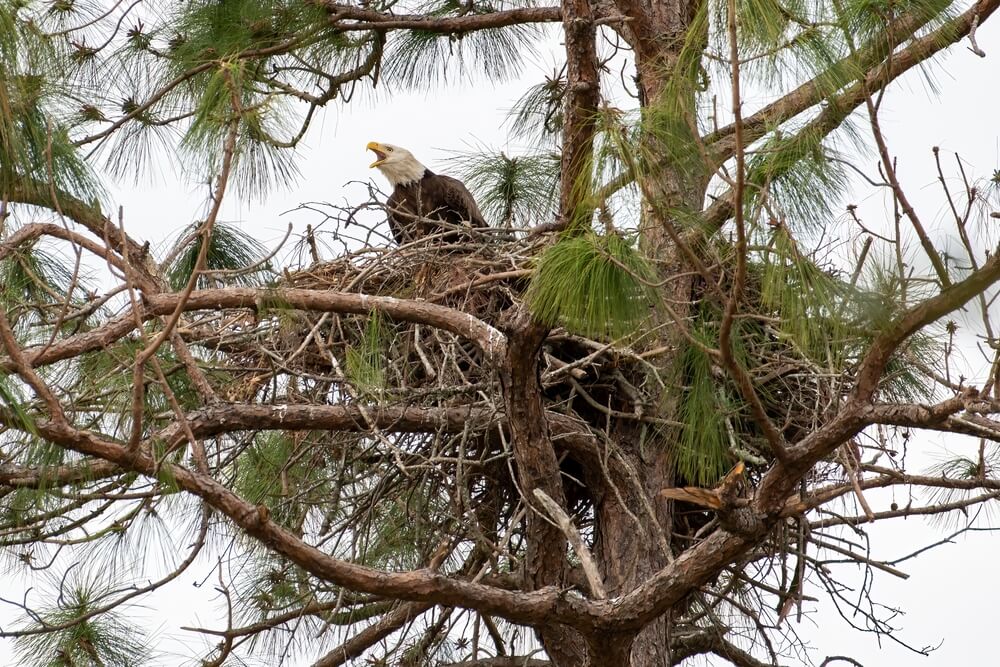
The bald eagle is a national symbol, and many birdwatching enthusiasts would like to spot one. However, you must know what to look for to avoid confusion with ospreys and other common raptors.
Adult bald eagles are the easiest to identify thanks to their white heads and tails. The body and wings are dark brown, while the beak and eyes are a bright yellow. Most young birds attain adult plumage at about five years of age.
Juvenile bald eagles are entirely brown with a black beak and brown eyes. The plumage on the head and tail starts transitioning to white at about one and a half years, and this is when the beak and eyes also start losing pigment, becoming lighter in color.
A young bald eagle of about two and a half years has about half of its head and tail feathers white, an almost dark yellow beak, and dark yellow eyes.
Size-wise, an adult bald eagle measures around 28 to 40 inches in height and has a wingspan between 5.11 and 7.7 feet. Females are about 25 percent larger than males, but apart from this distinction, there are no differences in colors or markings.


